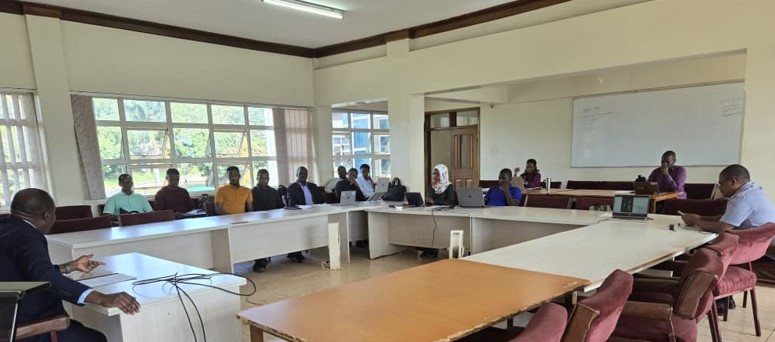Through its seed grant program, the Directorate of Research, Innovation Services, and Engagement provides critical funding to the students and staff of the College of Computing and Information Sciences. This initiative aims to catalyze the development of new startups and advance groundbreaking research. Following the successful Call 003, the Grants Office hosted a workshop to facilitate the sharing of results, allowing researchers to present their significant findings and innovations, which are summarized in this report.
Research Projects that were Presented.
| No. | Staff Name | Project Title | |
| 1 | Dr. Steven Odongo | COdetect: An In-door Carbon Monoxide (CO) Emission Level Detection and Analysis Tool for Remote Low Resource Rural Households using Sensors | |
| Findings/ Outcomes | |||
| Developing an intelligent detector for carbon dioxide and other pollutants | |||
| No. | Staff Name | Project Title | |
| 2 | Mr. Marvin Galiwango. | Diabetes Screening Using the Responsible Medical Corpus (RMC) | |
| Findings/ Outcomes | |||
| Current diabetes screening in Uganda relies on a patchwork of community health worker (CHW)initiatives, mobile clinics, and paper-based risk scores like the Finnish Diabetes Risk Score(FINDRISC). CHWs, while vital, face challenges: a 1:5,000 provider-to-patient ratio, variable training quality,and manual data entry errors (15–20% in glucose logs).Mobile health (mHealth) tools like SMS-based reminders have shown promise but struggle withengagement—only 40% of users complete follow-up screenings. AI-powered platforms, such assmartphone retinopathy analyzers, are emerging but require high-resolution cameras and cloudconnectivity, which is scarce in rural Uganda. Crucially, existing AI models for diabetes prediction (e.g., logistic regression on BMI/age) lackconversational interfaces, excluding illiterate populations (24% of Ugandan adults). Meanwhile,large language models (LLMs) like ChatGPT could democratize access via conversational andvoice-based, low-literacy interfaces but face critical barriers: hallucinated diagnostic thresholds(e.g., “HbA1c ≥7% is normal”), | |||
| No. | Staff Name | Project Title | |
| 3 | Dr. Emily Bagarukayo | Development of Neura E-Health System For Improving Healthcare Efficiency In Developing Countries with a focus on Uganda. | |
| Findings/ Outcomes | |||
| Healthcare access in most developing countries is constrained by; High population densities with stretched health care systems.Few health facilities.Low Health provider patient ratios.Most procedures are manually operated. The COVID 19 pandemic has exacerbated the access challenges. Increased self medication and some people have completely no access to care. SolutionUndertaking a phased approach to the development of an affordable integrated system that would enhance;Patient record management, Appointments and other operations management.Pharmaceutical access, Community insurance and social support | |||
| No. | Staff Name | Project Title and Findings | |
| 4 | Dr. Nasser Kimbugwe | Despite efforts to provide free ARVs, many HIV-positive individuals in Uganda struggle with accessibility due to logistical challenges, economic constraints, and social stigma. Healthcare facilities, particularly in rural areas, frequently experience stockouts, delaying treatment for those who need it most. Stigma further exacerbates the issue, as fear of discrimination discourages individuals from seeking ARVs or adhering to their treatment. This results in preventable HIV-related complications and deaths. Leveraging ICT solutions presents an opportunity to streamline ARV distribution, improve adherence, and ensure confidentiality, thereby addressing these persistent challenges and reducing HIV-related mortality. FindingsICT could bridge access and stigma gaps if platforms ensure user privacy and are culturally sensitive. | |
| No. | Staff Name | Project Title and Findings | |
| 5 | Dr. Rose Nakibuule | Justice and Deception Risk Stratification Scalp Strap-on Technology and Artificial Intelligence (AI) enabled Application (Tolimba).Lck of timely and accurate information have resulted into wrongful convictions and some time has led to torture of the the victims inorder to extract the truthful information from the victims.Development of an automated system that can extract vital information from suspects by studying their brain waves and responses during interrogation and court proceedings.The solution harnesses the power of Brain Computer Interface (BCI) and Electroencephalography (EEG) technology to actively detect, record and capture electrical activity of the brain in the form of brain wave signals | |
| No. | Staff Name | Project Title and Findings | |
| 6 | Moses Ntanda Kyebambe | Project Title: Public LoRaWAN Gateways for Educational ResearchUganda lacks public LoRaWAN gateways, limiting technological advancement compared to Kenya, Tanzania, and Rwanda.This project will Establish public LoRaWAN gateways in Uganda to support education, research, and innovation.Enhancing education, research, and socio-economic growth through IoT technology. | |
| No. | Staff Name | Project Title and Findings | |
| 7 | Dr. Nagwovuma Margret. | Using IOT and AI to mitigate post harvest handling losses in Uganda: Feasibility study in Uganda for cereals | |

Impact & Outcomes
Each presenter showcased a tangible innovation or research outcome. It is important to note that some projects are still in progress. Among the developments presented were:
- An In-door Carbon Monoxide (CO) Emission Level Detection and Analysis Tool for remote Low Resource Rural Households using Sensors.
- A Diabetes Screening System that used Responsible Medical Corpus (RMC)
- Development of Neura E-Health System For Improving Healthcare Efficiency In Developing Countries with a focus on Uganda
- Establish public LoRaWAN gateways in Uganda to support education, research, and innovation.
- Justice and Deception Risk Stratification Scalp Strap-on Technology and Artificial Intelligence (AI) enabled Application.
- An ICT-driven system for ARV distribution and stigma reduction was proposed.
- National Dashboard for Monitoring Teaching Load Allocation and Teaching Timetable Management for All Academic Staff in Public Universities in Uganda
- Automated-Vision-based Goat Breed identification in Uganda using Deep learning
- Groundnut variety,pest and disease identification using explainable machine learning.


